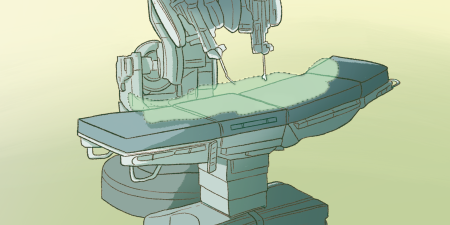Abstract
This commentary on a case considers how to cultivate resident surgeon professional autonomy while ensuring patient safety. Specifically, the commentary briefly canvasses strategies for how to disclose the nature and scope of resident surgeon involvement in managing intraoperative care to patients and their loved ones. The commentary also suggests how to manage patients’ and their loved ones’ expectations and assumptions about surgical innovation, including robot-assisted surgery.
Case
Dr B is a fourth-year general surgery resident physician and chief of the University Hospital minimally invasive surgery service. Dr B spends most of her time in the operating room (OR) with attending physician, Dr A, who performs laparoscopic and robot-assisted operations. Today, Dr B is instructed by Dr A to sit at the robot console. Dr B performs portions of a ventral hernia repair independently in the presence of Dr A. Dr A gives the console control to Dr B, instructing her to suture in the mesh after the primary closure of the hernia defect. Dr B is startled, as she has begun, but not yet completed, suggested robotic training console simulations for hernia repair and has only sewn in part of this particular mesh before. Dr B seizes the opportunity and wonders what the patient and family should be told, perhaps now and certainly later, about her role in the surgery.
Commentary
This case highlights an important obligation at the heart of surgical education: ensuring that the patient receives the best possible care while training the next generation of surgeons. It also calls attention to the question of the extent of training a trainee should be required to accomplish outside of the OR prior to operating on a patient. Furthermore, it questions to what extent an attending physician must delineate and clarify resident and faculty intraoperative roles to a patient both prior to surgery and when those roles change during the course of the operation. Finally, this case offers an opportunity to consider the extent to which surgeons should explain increasingly complex technical tools and newly implemented innovations to patients such that they can be fully informed when completing the consent process.
Training Robotic Surgeons
In this case, Dr B is “startled” when given the controls to independently perform a portion of the surgery that she has not previously done in the OR or in simulation. Her questioning of what and when the family should be told about her level of participation implies that she thinks her involvement puts the patient at an increased risk of a worse outcome. The case scenario also implies that if surgical residents have not performed a task in a simulated environment, then they should not perform it in the OR because it may have a negative effect on patient outcomes.
If a surgical resident’s participation in surgery results in a worse patient outcome, then the attending surgeon is not upholding the basic ethical tenet of nonmaleficence. Yet it may be difficult to know in the moment how a surgical resident’s participation could affect a patient’s outcome. This uncertainty is further complicated by the fact that surgical residents are trained by multiple attending surgeons, making it challenging for an individual attending surgeon to know the full range of technical abilities and intraoperative decision-making capabilities of a given surgical resident.
As operations evolved to incorporate increasingly complex techniques, the “see one, do one, teach one” model has not been sustainable.
There is evidence to suggest that surgical resident participation in the OR does not negatively affect patient outcomes and may even decrease patient mortality.1,2,3,4,5 Standardized operative performance assessments and their association with patient outcomes are active areas of surgical education research.6 Until the development of an assessment that predicts how a resident will perform in an operation, attending surgeons should use their experience with a surgical resident to inform the tasks a resident may be permitted to do under supervision in the OR. In the case above, Dr A works with Dr B frequently and therefore has a robust understanding of her technical abilities. While Dr B may be unsure of herself, Dr A is giving her supervised graduated autonomy while upholding patient beneficence and nonmaleficence.
Surgical education has evolved over time due to advances in research focused on education as well as administrative and regulatory constraints on surgical training programs.7 Historically, teaching surgical residents to operate followed the “see one, do one, teach one” method. As operations evolved to incorporate increasingly complex techniques, this model has not been sustainable.6,8 With the development of laparoscopic and robot-assisted surgery, there has been an increase in surgical simulation and training labs aimed at providing residents opportunities to practice and develop technical skills outside of the OR.9,10,11 Robot-assisted surgery simulation curricula, however, have not yet demonstrated improvement in operative skill, and there are no data that we know of demonstrating the effectiveness of simulation curricula in improving patient outcomes.12,13,14 Thus, the value of current simulation curricula has not yet been determined.15 When considering this case, the lack of evidence-based research demonstrating that simulation curricula improve operative skills supports Dr A’s reliance on personal judgment to determine the capabilities of Dr B inside and outside of the OR.
Disclosing Surgical Roles and Managing Expectations
In the case presentation, there is no description of Dr A providing disclosure to the patient and obtaining informed consent prior to surgery. The case ends with Dr B wondering what the patient should be told about her role in the surgery. It is not clear if Dr B was present for the preoperative discussion that Dr A had with the patient. Although disclosure of surgical residents’ intraoperative role was historically neglected in preoperative patient conversations, there is a growing literature on the importance of such disclosure to support patient autonomy.16,17 Previously published work on this topic in this journal has discussed the importance of standardized disclosure language and the timing of disclosure.18 However, robot-assisted surgery adds a new component to this discourse.
Intuitive Surgical, Inc recently released a mobile application that records and displays operative metrics of attending surgeons and surgical residents. The application uses data from the Da Vinci surgeon console to track which part(s) of the operation an individual performs, the movements made, the instruments used, and other relevant data.19 The use of these data in surgical education has potential to facilitate enhanced review of operations, resulting in a shorter learning curve that may benefit future patients. At the same time, operative data with this level of specificity could be desirable in a medical-legal context if an error occurred in the OR that resulted in harm to the patient on the table. The robotic application should be considered analogous to a surgical department case review (ie, a morbidity and mortality conference), which is exempt from medical-legal proceedings. These conferences are an opportunity for peer review of surgical errors and discussion of options that may prevent similar errors from occurring in the future.
The availability of data specifying who was operating at certain times during a case forces us to consider what details of a resident’s intraoperative role attending surgeons should share with a patient in the preoperative disclosure and informed consent process. Should every surgery be stratified into segments and each segment assigned a team member? This approach may offer the patient more information and hence greater autonomy, but it may be impractical. It may also restrict intraoperative role changes if the clinical scenario differs from what the surgeon anticipated. It is common for the preoperative plan of the trainee’s role in the operation to change during an operation. Typically, this role change occurs when the operation becomes more complicated, necessitating that the trainee’s involvement be reduced. Even in these scenarios, however, the trainee is actively assisting in the surgery. Whether or not a role change occurs, after the surgery is complete, it is expected that the surgeon will provide an overview of the operation that includes discussion of whether it was more complicated than expected. However, it is not expected that the surgeon would—and it would not be practical for the surgeon to—give a detailed, play-by-play description of each surgical step.
Finally, as new surgical technology and techniques are introduced, the medical device industry has recognized the value of marketing to the public. As a result, patients and their loved ones may bring preconceived ideas to the informed consent conversation. Specific to robot-assisted surgery, patients may be concerned about the role of the robot vs the role of the surgeon and whether the surgeon will be in the room for the duration of the operation. Educating patients and their loved ones about the roles of the robot helps patients consent to or decline surgery.
Conclusion
The growth of robot-assisted surgery and other novel surgical tools and techniques offers opportunities to reinforce ethical tenets of nonmaleficence and autonomy. Accordingly, attending surgeons should disclose the roles of residents in operations during consent processes. Surgical data from technology applications enhance educational quality and should not be subject to medical-legal proceedings. Finally, surgical residents must learn not only how to perform increasingly complex operations, but also how to explain these operations and all surgical team members’ roles.
References
-
Webster H. Is surgery safer at a teaching hospital? US News & World Report. October 27, 2014. Accessed January 20, 2023. https://health.usnews.com/health-news/patient-advice/articles/2014/10/27/is-surgery-safer-at-a-teaching-hospital
-
Conageski C. The benefits of having surgery at a teaching hospital. University of Colorado OB-GYN blog. June 28, 2017. Accessed January 20, 2023. https://obgyn.coloradowomenshealth.com/blog/benefits-surgery-teaching-hospital
-
Meguid RA, Brooke BS, Chang DC, Sherwood JT, Brock MV, Yang SC. Are surgical outcomes for lung cancer resections improved at teaching hospitals? Ann Thorac Surg. 2008;85(3):1015-1024.
- Saliba AN, Taher AT, Tamim H, et al. Impact of resident involvement in surgery (IRIS-NSQIP): looking at the bigger picture based on the American College of Surgeons-NSQIP database. J Am Coll Surg. 2016;222(1):30-40.
-
Wexner T, Rosales-Velderrain A, Wexner SD, Rosenthal RJ. Does implementing a general surgery residency program and resident involvement affect patient outcomes and increase care-associated charges? Am J Surg. 2017;214(1):147-151.
-
Busch KM, Yeshiva HB, Kuy S, Nezgoda J, Allard-Picou A. Teaching in the OR: new lessons for training surgical residents. Bull Am Coll Surg. August 1, 2015. Accessed January 21, 2023. https://bulletin.facs.org/2015/08/teaching-in-the-or-new-lessons-for-training-surgical-residents/
-
Camison L, Brooker JE, Naran S, Potts JR III, Losee JE. The history of surgical education in the United States: past, present, and future. Ann Surg Open. 2022;3(1):e148.
-
Polavarapu HV, Kulaylat AN, Sun S, Hamed O. 100 years of surgical education: the past, present and future. Bull Am Coll Surg. July 1, 2013. Accessed January 21, 2023. https://bulletin.facs.org/2013/07/100-years-of-surgical-education/
- Palter VN, Grantcharov TP. Simulation in surgical education. CMAJ. 2010;182(11):1191-1196.
-
Badash I, Burtt K, Solorzano CA, Carey JN. Innovations in surgery simulation: a review of past, current and future techniques. Ann Transl Med. 2016;4(23):453.
- Disbrow DE, Pannell SM, Shanker BA, et al. The effect of formal robotic residency training on the adoption of minimally invasive surgery by young colorectal surgeons. J Surg Educ. 2018;75(3):767-778.
-
Mills JT, Hougen HY, Bitner D, Krupski TL, Schenkman NS. Does robotic surgical simulator performance correlate with surgical skill? J Surg Educ. 2017;74(6):1052-1056.
-
Howard KK, Makki H, Novotny NM, Mi M, Nguyen N. Value of robotic surgery simulation for training surgical residents and attendings: a systematic review protocol. BMJ Open. 2022;12(6):e059439.
-
Chen R, Rodrigues Armijo P, Krause C, Siu KC, Oleynikov D; SAGES Robotic Task Force. A comprehensive review of robotic surgery curriculum and training for residents, fellows, and postgraduate surgical education. Surg Endosc. 2020;34(1):361-367.
-
Green CA, Chern H, Rogers SJ, Reilly LM, O’Sullivan P. Transforming surgical education through a resident robotic curriculum. Ann Surg Open. 2021;2(3):e076.
- Porta CR, Sebesta JA, Brown TA, Steele SR, Martin MJ. Training surgeons and the informed consent process: routine disclosure of trainee participation and its effect on patient willingness and consent rates. Arch Surg. 2012;147(1):57-62.
-
Wojcik BM, Phitayakorn R, Lillemoe KD, Chang DC, Mullen JT. Preoperative disclosure of surgical trainee involvement: Pandora’s box or an opportunity for enlightenment? Ann Surg. 2017;265(5):869-870.
-
Kirsch MJ, Kasten SJ. What about learners’ roles in the operating room should be disclosed to patients? AMA J Ethics. 2018;20(4):336-341.
-
My intuitive. Intuitive. Accessed September 26, 2022. https://www.intuitive.com/en-us/products-and-services/my-intuitive



